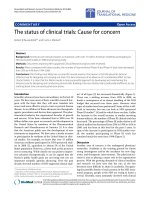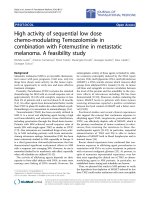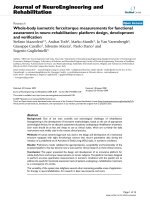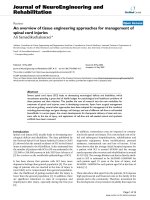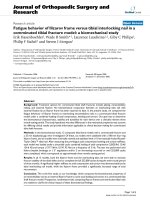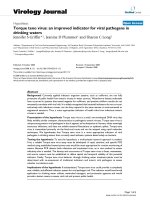báo cáo hóa học:" Predictive value of ovarian stroma measurement for cardiovascular risk in polycyctic ovary syndrome: a case control study" pptx
Bạn đang xem bản rút gọn của tài liệu. Xem và tải ngay bản đầy đủ của tài liệu tại đây (257.61 KB, 7 trang )
RESEARC H Open Access
Predictive value of ovarian stroma measurement
for cardiovascular risk in polycyctic ovary
syndrome: a case control study
Giuseppe Loverro
1*
, Giovanni De Pergola
2
, Edoardo Di Naro
1
, Massimo Tartagni
1
, Cristina Lavopa
1
,
Anna Maria Caringella
1
Abstract
Background: To verify the feasibility of ovarian stromal evaluation and correlate ovarian parameteres (echogenicity
and volume) with hyperandrogenism, and both cardiovascular and metabolic risk factors in PCOS.
Methods: Twenty four young PCOS patients and twelve age-matched control women were enrolled. Diagnosis of
PCOS was based on the Rotterdam criteria. Ultrasound ovarian study included ovarian volume, stromal volume,
stromal area and stromal area/total ovarian area ratio (S/A). Concerning hormones, insulin, LH, FSH, estradiol,
androstenedione, testosterone, DHEAS, 17-hydroxy-progesterone, and SHBG were measured during the early
follicular phase (days 2-5). Cardiovascular risk factors were represented by fasting plasma levels of glucose, lipids
(total and HDL-cholesterol), plasminogen activator inhibitor 1 (PAI-1), von-Willebrand factor (vWF), and adiponectin.
Carotid intima-media thickness (C-IMT) was measured as a parameter of cardiovascular risk.
Results: A positive correlation between the S/A ratio and plasma levels of testosterone (p < 0.05) and
androstenedione (p < 0.05) was found. The stromal volume, stromal area and S/A ratio were also significantly and
positively correlated with PAI-1, and vWF levels, and with IMT in PCOS women (P < 0.05).
Conclusions: This study shows that the ultrasound measurement of ovarian stroma is a predicting factor of
hyperandrogenism degree, prothrombotic factors and cardiovascular risk in patients with PCOS.
Background
Polycystic ovary syndrome (PCOS) is an e ndocrine dis-
order that affects 7-8% of women during reproductive
age and is currently considered the most common cause
of female infertility [1,2].
Oligo-anovulation, clinic al hyperandrogenism, obesity,
elevated levels of circulating androgens and LH [2-4],
insulin resistance and/or compensatory hyperinsuline-
mia are features not invariably associated with the syn-
drome [5].
The strict criteria for diagnosis of PCOS have been
long debated, but a recent joint ASRM/ESHRE consen-
sus has proposed a new definition of the syndrome, that
includes and emphasizes the morphology of polycystic
ovaries [6].
In this definition, at least two o f the fo llowing three
criteria are necessary for diagnosis: 1) oligo- and/or ano-
vulatio n, 2) hyperandrogenism (clinical and/or biochem-
ical), and 3) the ultrasonic appearance of polycystic
ovaries.
Concerning ultrasounds diagnostic criteria of PCOS,
these have progressively changed accordingly to techno-
logical improvement, evolving from a simple evaluation
of the ovarian volume to the identification of a typical
follicular pattern and, lastly, to modifications of the
ovarian stroma [7].
The presence of 12 or more follicles measuring 2-9
mm in diameter and increased total ovarian volume
(>10 cm
3
) are considered satisfying criteria for ultrasonic
identification of PCOS, since they have enough specifi-
city and sensitivity [8].
* Correspondence:
1
Clinic of Obstetrics and Gynecology III, University of Bari, School of
Medicine, Policlinico, Piazza Giulio Cesare, 70124 Bari, Italy
Full list of author information is available at the end of the article
Loverro et al. Journal of Ovarian Research 2010, 3:25
/>© 2010 Loverro et al; licensee BioMed Central Ltd. This is an Open Access article distributed under the terms of the Creative Commons
Attribution License (<u rl> which permits unrestricted use, distribution, and
reproduction in any medium, provided the original work is properly cited.
Although various authors have emphasized the diag-
nostic value of ovarian stroma measurement, this para-
meters has been confined to the research field. Even
though ovarian stromal hypertrophy is largely involved
in the pathophysiology of PCOS [6] and it could be
properly identified by vaginal endosonography [9], the
acceptance of ultrasound ovarian stromal hypertrophy
as a addit ional criterion for diagnosis of PCOS is still
controversial. This is due to the fact that results a re
strictly dependent on both the experience of the opera-
tor and the quality of ultrasound machine equipment,
with a risk of low reproducibility of ultrasound measure-
ments. By contrast, in our opinion, ultrasound ovarian
stromal evaluation may be useful in increasing the pre-
dictivity of diagnosis. The sensitivity and specificity of
ultrasounds ovarian stromal measurement have been
shown to be 94% and 90% respectively, in the diagnosis
of polycystic ovaries [10]. Moreover, Venturoli et al have
suggested that higher stroma v olume or higher stroma
area are the most sensitive and specific ultrasoni c para-
meters of PCO [11]. Interestingly, higher stromal
volume and echodensity, observed by ultrasounds, have
been shown to correspond to prominent theca lutheal
cells described by Stein and Leventhal [12], and dou-
bling of cross-sectional ovarian area, observed by ultra-
sound, has been shown to be expression of a marked
increase (33%) of cortical portion, and of a five-fold
increase of medullar stroma [13] in PCOS. Lastly, Kyei-
Mensah et al have shown that a higher ovarian size in
patients with PCO is mainly accounted for by the differ-
ences in stro mal volume, with no significant changes in
the follicular/cortical volume [14]. Many parameters to
judge the ovarian morphological alterations has been
adopted: doubling of the cross-sectional area, doubling
of the number of ripening and atresic follicles, a 50%
increase in tunica thickness, a 33% increase of cortical
and a five-fold increase of medullar stroma [13].
The present study, performed in young and never
treated nulliparous PCOS women, has been addressed
to evaluate the possible routinary clinical feasibility of
ultrasounds ovarian stromal evaluation and its correla-
tion with androgens, insulin resistance (HOMA test),
and instrumental and metabolic makers of early
atherosclerosis.
Methods
Subjects
Women were enrolled according to specific inclusion
criteria in order to provide a homogeneous group of
patients. Inclusion criteria were the diagnosis of PCOS,
the absence of previous pregnancy or previous hormone
or any other medical treatment and age ≤ 27 years.
Diagnosis of PCOS was based on the presence of
two out of three criteria second revised Rotterdam
consensus [6]: unilateral or bilateral polycystic ovaries
(PCO) on transvaginal scan, clinical or biochemical fea-
tures of hyperandrogenism and menstrual irregularity
(chronic ano vulation with ameno rrhea or chroni c
oligoamenorrhea).
Hyperandrogenaemia was defined on the basis of high
serum androgen levels, mainly testosterone (≥0.6 ng/ml)
and andro stenedione (≥3.0 ng/ml). Clinical hyperandro-
genism was defined by the presence of hirsutism. This
was assessed by the Ferriman-Gallwey-Lorenzo scores,
with patients having scores ≥8 being considered as
hirsute.
Exclusion criteria were smoking habit, no ovarian
causes of hyperandrogenism (adrenal enzymatic defi-
ciencie s, Cushing’s syndrome and tumors), manifest dia-
betes mellitus, hyperprolactinemia, any respiratory or
cardiovascular disease, hypertension, and any hormonal
or drug treatment (including oral contraceptives) over
the 6 months before the study.
On this basis, twenty four women with PCOS were
enrolled consecutively at the Outpatient Clinic of Obste-
trics and Gynecology Department, University of Bari,
School of Medicine.
Twelve age-matched healthy volunteer women were
examined as control group. They had normal ovaries,
no evidence of hyperandroge nemia (hirsutism), and reg-
ular menstrual cycles, as we ll, they had never been trea-
ted for menstrual disturbances, infertility or hirsutism at
any time.
The study was approved by the Institutional Review
Board of the Bari University Hospital, and informed
consent was obtained from all women before entry into
the study. The investigation was pe rformed according to
the principles expressed in the “Declaration of Helsinki”.
Anthropometric measurements and general data
Weight was measured to the nearest kg. Height was
determined to the nearest meter ( m). BMI was calcu-
lated as the weight (kg) divided by the square of height
(m). The minimum waist measurements between the
pelvic brim and the costal margin, and the maximum
hip measurement at 5° the level of the greater trocan-
ters, were used to calculate the waist/hip ratio (WHR).
Systolic and diastolic blood pressure was evaluated in
three different occasions in the right arm with the sub-
jects in a relaxed sitting position in all patients and con-
trols. All women under study were normotensive.
Hormonal and metabolic parameters
After an overnight fast, blood samples were drawn at 8 a.
m. during the early follicular phase (cycle day 2, 3, 4 or 5)
to measure the plasma levels of hormones, glucose, lipids
and other metabolic and cardiovascular risk factors. Hor-
monal study included insulin, LH, FSH, estradiol, andros-
tenedione (A), testosterone (T), dehydroepiandrosterone
sulphate (DHEAS), 17-hydroxy-progesterone (17-OHP),
Loverro et al. Journal of Ovarian Research 2010, 3:25
/>Page 2 of 7
sex hormone-binding globulin (SHBG) and prolactin
(PRL). Plasma LH, FSH, estradiol, T, A, DHEAS, 17-OHP
and PRL concentrations were measured by using a
recombinant immunoassay, whereas SHBG was mea-
sured using a RIA. For all measurements, commercial
kits were used (Diagnostic System Laboratories, Inc.,
Webster. TX), with intra- and interassay coefficients of
variation <10%.
Plasma insulin concentrations were measured by
radioimmunoassay (Behring, Scoppitto , Italy) and intra-
and inter-assay coefficients of variation were 3.7% and
7.5% respectively. Plasma glucose levels were determined
by the glucose-oxidase method (Sclavo, Siena, Italy).
Plasma adiponectin was measured by a specific RIA
obtained from Linco Research,Inc.(St.Charles,MO),
with minor modificati ons. Recombinant human adipo-
nectin was used as standard, and a multispecies adipo-
nectin rabbit antiserum was used. The assay buffer
contained 10.0 mmol phosphate buffer, pH 7.6, sodium
azide (0.09%) and BSA (0.15%). The intra- and interas-
say coeffici ents of variatio n were 3.3% and 8.4%, respec-
tively. Insulin resistance was assessed by using the
homeostasis model assessment (HOMA
IR
), based o n a
mathematical correlation between fasting plasma glucose
and insulin levels [15].
Prothrombotic parameters
Subjects lay down in the supine position for 20 min
before blood collection. Blood samples for PAI-1 antigen
and vonWillebrand factor antigen (vWF) were kept on
crushed ice until centrifugation. Samples were centri-
fuged at 250 0 × g for 15 min at 4°C within 15 min after
blood collection. The resulting plasma was stored in
smal l aliquots in a -70°C freezer until assay. PAI-1 anti -
gen and vWF concentrations were determined as pre-
viously described [16]. Both intra-assay and inter-assay
coefficients of variation in all the above methods were
less than 7.5%
Ultrasound ovarian parameters
US examinations were performed in the early follicular
phase (days 1 ± 3) of the menstrual cycle, when the
ovaries are relatively quiescent by a single operator fol-
lowing the criteria of the Rotterdam ESHRE/ASRM
Consensus, 2004 [6]. Transvaginal US (TVUS) was per-
formed on each patient using a 6.5 MHz transvaginal
transducer (Aloka ALPHA 10 PROSOUND (Aloka,
Tokyo, Japan): ovarian volume, ovarian area, stromal
area , S/A ratio and the number, diameters and distribu-
tion of follicles were recorded.
The transabdominal route was not used . In fact, it has
been argued that transvaginal ultrasound is a more sen-
sitive method for the detection of polycystic ovaries.
In the TVUS data used for statistical analysis were the
mean of observed values for the left and right ovaries.
It was identified each ovary and measured the maxi-
mum diameter in each of three planes (longitudinal,
antero-posterior and transverse).
Ovarian volume ( OV) was calculated for each ovary
using the formula for a prolate ellipsoid: π/6 × (D1 ×
D2 × D3), where D represented the maximum diameter
in transverse, antero-posterior and long section. The
ovarian area (OA) and stromal area (SA) were per-
formed using the formula for an ellipse (length × width
× π/4) and following the mean stroma/total area (S/A)
ratio was obtained.
Notewo rthy, the reproducibility of the stromal volume
measurement was very similar to that of the ovarian
volume.
Themeanofthestromaofthetwoovarieswasused
for each patient in statistical analyses
Evaluation of common carotid artery IMT
Ultrasonographic studies of common carotid arteries
were performed bilaterally by a single observer. The
value of common carotid arteries that was considered
for statistical analyses was the mean of right and left
measurements. All studies were performed with a Hew-
lett Packard Sonos 1500 (Hewlett Packard, Avondale,
PA, USA) using a 7.5 MHz high-resolution probe. IMT
was defined as a low-lev el echo grey band that does not
project into the arterial lumen. It was measured during
end-diastole as the distance from the leading edge of
the second echogenic line of the far walls of the distal
segment of the common carotid artery, the carotid
bifurcation, and the initial tract of internal carotid artery
on both sides. Measurements were performed 0.5, 1,
and 2 cm below the bifurcation (three measurements on
each side), an d the average measurement was taken as
the IMT. IMT measurements were always performed in
plaque-free arterial segments.
Statistics
Results are presented as mean ± standard deviation (SD)
for all para meters. Variables with a skewed distribution
(waist circumference, insulin, HOMA
IR
,PAI-1)were
logarithmically transformed before analyses, to improve
the approximation to a Gaussian distribution. Student’s
t-test for independent samples was u sed to evaluate the
differences between groups.
P values < 0.05 were considered statistically signifi-
cant. All statistical analyses were performed using the
STATISTICA 6.0 for Windows, StatSoft Inc. (1995)
software (Tulsa, OK, USA).
Results
Table 1 shows general, anthropometric (age, BMI WHR)
data of PCOS and control women. PCOS patients pre-
sented a significantly higher BMI, WHR (P < 0.05).
Loverro et al. Journal of Ovarian Research 2010, 3:25
/>Page 3 of 7
Plasma concentrations of vWF, fasting blood glucose,
total cholesterol were not significantly different between
the two groups (P = 0.15; P = 0.17; P = 0.17), whereas
the levels of fasting insulin, HOMA
IR
,colesterolHDL
and PAI-were higher in PCOS patients (P < 0.05). Note-
worthy, the level of serum adiponectin were lower in
PCOS women in respect to the control (P = 0.001)
(Table 2).
The levels of plasma FSH, estradiol, and 17 OHP did
not differ (P = 0.52; 0.86; 0.15) between the groups. The
LH, Androstenedione, Testosterone, DHEA-S and
SHBG concentration was significantly higher in PCOS
(P < 0.05) (Table 3).
Analysis of the ultrasound appearance of the ovaries
showed that PCOS patients showed had a higher ovarian
and stromal volume, stromal area and a higher area
stromal area/area ovary ratio (S/A ratio) compared with
the control women (P < 0.05) (Table 4).
The total ovarian area was not significantly different
between the two groups.
The correlation between ovary ultrasound measure-
ment and anthropometric/metabolic parameters has
been performed in PCOS subjects and control women
in order to clarify the clinical significance of the above
specified ultrasound measurement (Table 5).
A significant correlation has been found between the
ultrasound measurements and some biochemical and
anthropometric characteristics. In fact, we observed the
direct association between ovarian volume and BMI (p <
0.05), WHR (p < 0.01), and total cholesterol (p < 0.05),
as well between the ovarian area and WHR (p < 0.01).
As endocrine point of view, a positive correlation
between the S/A ratio and the plasma levels of testoster-
one(p<0.05)andandrostenedione(p<0.05)hasbeen
found.
An important finding was a linear relationship
between the ultrasound parameters of the stroma and
some cardiovascular risk factors (Table 6)
In fact, stromal volume, stromal area and S/A ratio are
significantly and positively correlated, in PCOS women,
with the level of PAI-1, von Willebrand factor and with
intima media thickness (IMT).
The IMT of carotid artery demonstrated a significant
linear correlation with not only stromal US parameters
but also with ovarian volume and area evaluation.
The levels of adiponectin were significantly correlate
with stromal measurement, mainly with S/A ratio.
Table 1 General anthropometric in PCOS and control
women
PCOS Control
N = 24 N = 12 P-value
Age (years) 22.87 ± 4.28 21.66 ± 5.15 P = 0.46
BMI (weight/m2) 31 ± 7.0 25.16 ± 6.97 P = 0.02
a
Waist/Hip ratio (WHR) 0.87 ± 0.15 0.84 ± 0.12 P = 0.00
a
Values are mean ± SD;
a
P < 0.001 (Student’s t test) PCOS vs control group.
Table 2 Metabolic and cardiovascular risk parameters in
control women and in women with PCOS
PCOS Control
N=24 N=12 P-value
Fasting blood
glucose (mg/dl)
86.29 ± 9.90 82.08 ± 5,12 P = 0.17
Fasting insulin
(mUI/ml)
22.0 ± 12.0 7.65 ± 5.48 P = <0.001
a
HOMA
IR
4.54 ± 2.77 1.82 ± 1.17 P = <0.05
a
Total cholesterol
(mg/ml)
183.4 ± 30.35 168.6 ± 29.30 P = 0.17
HDL cholesterol
(mg/ml)
51 ± 8,67 59,16 ± 9,19 P = <0.05
a
PAI-1 (ng/ml) 37,80 ± 20,98 17.2 ± 18.2 P = 0.007
a
F von Willebrand
(%)
86,86 ± 34,25 103,65 ± 27,75 P = 0.15
Adiponectin 6,05 ± 3,84 24 ± 4,26 P = 0.000
a
Values are mean ± SD;
a
P < 0.001 (Student’s t test) PCOS vs control group.
Table 3 Sex hormone levels in control women and in
patients with PCOS
PCOS Control
N=24 N=12 P-value
FSH (U/l) 4,77 ± 1,24 4,47 ± 1,48 P = 0.52
LH (U/l) 5,61 ± 3,44 3,17 ± 1,26 P = 0.02
a
E2 (pg/ml) 41 ± 35,56 39,05 ± 22,38 P =0.86
A (ng/ml) 3,09 ± 1,33 1.67 ± 0.83 P = 0.002
a
T (ng/ml) 0,65 ± 0,50 0.22 ± 0.08 P = 0.006
a
SHBG (nmol/l) 44,05 ± 2,27 54,55 ± 19,40 P = 0.01
a
DHEA-S (mg/m) 2,19 ± 0,69 1.61 ± 0.96 P = 0.04
a
17 0H P (ng/ml) 1,54 ± 1,87 0.74 ± 0.53 P = 0.15
Values are mean ± SD;
a
P < 0.001 (Student’s t test) PCOS vs control group.
Table 4 Ovarian ultrasound measurements in PCOS and
control women
Control PCOS
N = 12 N = 24 P-value
Ovarian Volume (cm
3
) 4.98 ± 2.91 9.13 ± 3.98 P = <0.01
a
Ovarian Area (cm
2
) 41.3 ± 16.3 47.4 ± 17.4 P = 0.31
Stromal Volume (cm
3
) 0.59 ± 0.66 11.4 ± 4.57 P = <0.001
a
Stromal Area (cm
2
) 8.12 ± 5.46 13.9 ± 6.10 P = <0.01
a
S/A ratio 4.37 ± 1.58 7.49 ± 4.45 P = <0.05
a
Values are mean ± SD;
S/A ratio = ratio between the stromal and the total ovarian area.
a
P < 0.001 (Student’s t test) PCOS vs control group.
Loverro et al. Journal of Ovarian Research 2010, 3:25
/>Page 4 of 7
None of total ovarian ultrasound measurements (ovar-
ian volume, ovarian area) demonstrated, in PCOS
patient, any positively correlation with this cardio meta-
bolic risk factor.
Discussion
The present study, performed in untreated young nulli-
paras women affected by PCOS, was addressed to evalu-
ate the possible associations between ovarian stroma,
measured by ultrasounds, and hormones, and metaboli c
and cardiovascular risk parameters.
PCO patients showed significantly higher ovarian
volume, stroma volume, stroma area and S/A ratio as
compared to the control group, confirming the diagnos-
tic role of ultrasounds stroma measurement in the eva-
luation of PCOS patients [17]. This is an important
result, since Joint ASRM/ESHRE consensus meeting on
PCOS established to take into account only the presence
of 12 or more follicles measuring 2 ± 9 mm in diameter,
and /or the increased ovarian volume (>10 cm3), for the
diagnosis of PCOS. Noteworthy, although ovarian
volume is more reliable in routinary clinical practice,
only ovarian stroma measurement may correspond to
histological findings of prominent theca and fibrotic
thickening of prominent lutheal cell albuginea, altera-
tions that explain many of clinical features of the syn-
drome [18].
We found a significant correl ation between ultrasono-
graphic S/A ratio and both testosterone and androstene-
dione serum levels. These results are in line with
previous studies showing that only ultrasound ovarian
stroma has a positive correlation with hyperadrogenic
status and androgens levels [7-18]. Therefore, evaluation
of the S/A ratio may enhance the predictive ability of
ultrasounds to identify women with PCOS, thus differ-
entiating polycystic and multifollicular ovaries, and
reducing the risk of false-positive or negative cases. For
istance, we could not find a significant correlation
between andro gen levels and total ovarian area or ovar-
ian volume, suggesting that ovarian volume is mainly
influenced by the number of follicles, whereas it is not
expression of PCOS endocrine impairment.
In this study, reproducibility of the measurements of
stromal volume was very close to that of ovarian volume
and of cortical follicular count; therefore, we strongly
believe that ultrasound determination of ovarian stroma
volume might be routinely used in clinical practice, at
least whether a modern ultrasound machine is used,
togheter to the determination of serum androgens or
the evaluation of Ferriman-Gallwey-Lorenzo scores.
Concerning the association of ultr asounds ovary para-
meters and cardiovascular risk variables, stroma volume,
stroma area, and S/A ratio showed a significant associa-
tion with well known cardiovascul ar risk fact ors such as
plasma levels of adiponectin, PAI-1 and vWF. Moreover,
stroma parameters showed a significant correlation with
CCA-IMT, that is a well known early sign of athero-
sclerosis. All these result s confirm several studies show-
ing that young PCOS women have an adverse
cardiovascular risk profile, and a higher cardiovascular
Table 5 Linear correlation (Rho-Spearman) between TVUS findings and hormonal and metabolic plasma levels
OV (cm3) OA (cm2) SV (cm3) SA (cm2) S/A ratio
BMI (weight/m2) P = 0.02
a
P = 0.45 P = 0.31 P = 0.37 P = 0.84
Waist/Hip ratio (WHR) P = 0.01
a
P < 0.01
a
P = 0.77 P = 0.07 P = 0.77
HOMA test P = 0.14 P = 0.14 P = 0.17 P = 0.53 P = 0.43
FSH (U/l) P = 0.73 P = 0.87 P = 0.72 P = 0.58 P = 0.72
LH (U/l) P = 0.24 P = 0.51 P = 0.62 P = 0.31 P = 0.13
A (ng/ml) P = 0.66 P = 0.15 P = 0.55 P = 0.81 P < 0.05
a
T (ng/ml) P = 0.76 P = 0.14 P = 0.97 P = 0.74 P = 0.03
a
SHBG (nmol/l) P = 0.94 P = 0.43 P = 0.38 P = 0.83 P = 0.77
DHEA-S (mg/m) P = 0.44 P = 0.35 P = 0.82 P = 0.89 P = 0.64
17 0H P (ng/ml) P = 0 P = 0.56 P = 0.78 P = 0.31 P = 0.19
Cholesterol (mg/dl) P < 0.05
a
P = 0.17 P = 0.92 P = 0.77 P = 0.56
a
P < 0.001 (Correlation and regression linear) PCOS vs control group.
Table 6 Linear correlation (Rho-Spearman) between TVUS findings and cardiovascular risck factors in PCOS group
OV (cm3) OA (cm2) SV (cm3) SA (cm2) S/A ratio
PAI-1 (ng/ml) P = 0.29 P = 0.21 P = 0.000
a
P = 0.000
a
P = 0.000
a
F von Willebrand (%) P = 0.15 P = 0.31 P = 0.000
a
P = 0.000
a
P = 0.000
a
Adiponectine P = 0.45 P = 0.21 P = 0.001
a
P = 0.000
a
P = 0.08
IMT P = 0.000
a
P = 0.000
a
P = 0.007 P = 0.000
a
P = 0.000
a
a
P < 0.001 (Correaltion and regression linear) PCOS vs control group.
Loverro et al. Journal of Ovarian Research 2010, 3:25
/>Page 5 of 7
risk [19,20]. Previous studies had clearly shown an asso-
ciation between PCOS and carotid intima-media thick-
ness [21] or anteroposterior diameter of infrarenal
abdominal aorta [22]. Moreover, other studies had
shown a correlation between PCOS and serum markers
of atherosclerosis such as CRP [23], interleukin-18 [24],
homocysteine [25], and endothelial dysfunction [26,27].
These data suggest a new role of ultra sound stroma
measurement in the evaluation of the cardiovascular risk
in young patients affected by PCOS, who do not show
clinical signs of cardiovascular disease.
Conclusions
In conclusion, this study shows that ultrasound mea-
surement of ovarian s troma is useful in predicting
hyperandrogenism severity and cardiovascular risk in
women affected by PCOS. In particular, the ratio
between stroma and total ovarian area is associated with
higher androgen serum levels, thus improving the diag-
nostic accuracy of PCOS, whereas the stroma itself is
related to t he intima-media thickness of common caro-
tid artery and the plasma levels of important prothrom-
botic factors such as PAI-1 and vWF. All these data
suggest a possible role of ultrasounds stroma measure-
ment in the diagnosis of PCOS and in the quantification
of cardiovascular risk in young pati ents affected by
PCOS.
Author details
1
Clinic of Obstetrics and Gynecology III, University of Bari, School of
Medicine, Policlinico, Piazza Giulio Cesare, 70124 Bari, Italy.
2
Section of
Internal Medicine, Endocrinology, Andrology and Metabolic Disease.
Department of Emergency and Organ Transplantation, University of Bari,
School of Medicine, Policlinico, Piazza Giulio Cesare, 70124 Bari, Italy.
Authors’ contributions
GL conceived of the study, and participated in its design and coordination
and helped to draft the manuscript. He have also given final approval of the
version to be published.
GP have made substantial contributions to acquisition of data.
EDN have made substantial contributions to analysis and interpretation of
data;
MT participated in the design of the study and performed the statistical
analysis.
CL have made substantial contributions to acquisition of data,
AMC have made substantial contributions to interpretation of data
All authors read and approved the final manuscript.
Competing interests
The authors declare that they have no competing interests.
Received: 17 July 2010 Accepted: 9 November 2010
Published: 9 November 2010
References
1. Azziz R, Woods KS, Reyna R, Key TJ, Knochenhauer ES, Yildiz BO: The
prevalence and features of the polycystic ovary syndrome in an
unselected population. J Clin Endocrinol Metab 2004, 89:2745-49.
2. Hull MG: Epidemiology of infertility and polycystic ovarian disease:
endocrinological and demographic studies. Gynecological Endocrinology
1987, 1:235-45.
3. Carmina E, Lobo RA: Polycystic ovary syndrome (PCOS): arguably the
most common endocrinopathy is associated with significant morbidity
in women. J Clin Endocrinol Metab 1999, 84:1897-99.
4. Dewailly D: Definition and significance of polycystic ovaries. In
Rosenfield, R.L. (ed.), Hyperandrogenic States and Hirsutism. Balliere’s Clin
Obstet Gynaecol 1997, 11:349-68.
5. Book CB, Dunaif A: Selective insulin resistance in the polycystic ovary
syndrome. J Clin Endocrinol Metab 1999, 87:3110-16.
6. The Rotterdam ESHRE/ASRM-Sponsored PCOS Consensus Workshop Group:
Revised 2003 Consensus on diagnostic criteria and long-term health
risks related to polycistic ovary syndrome. Fertil Steril 2004, 81:19-25.
7. Dewailly D, Robert Y, Helin I, et al: Ovarian stromal hypertrophy in
hyperandrogenic women. J Clin Endocrino Metab 1994, 41:557-62.
8. Balen AH, Laven JSE, Tan SL, Dewailly D: Ultrasound assessment of the
polycystic ovary: international consensus definitions. Hum Reprod Update
2003, 9:505-14.
9. Pache TD, Wladimiroff JW, Hop WC, Fauser BCJM: How to discriminate
between normal and polycystic ovaries: transvaginal ultrasound study.
Radiology 1992, 183:421-23.
10. Stein IF, Leventhal ML: Amenorrhea associated with bilateral polycystic
ovaries. Am J Obstet Gynecol 1935, 29:181-91.
11. Venturoli S, Porcu E, Fabbri R, et al: Longitudinal change of sonographic
ovarian aspects and endocrine parameters in irregular cycles of
adolescence. Pediatr Res 1995, 38:974-80.
12. Hughesdon PE: Morphology and morphogenesis of the Stein-Leventhal
ovary and of so-called ‘hyperthecosis’. Obstet Gynecol Surv 1982, 37:59-77.
13. Hughesdon PE: Morphology and morphogenesis of the Stein-Leventhal
ovary and of so-called ‘hyperthecosis’.
Obstet Gynecol Surv 1982, 37:59-77.
14. Kyei-Mensah AA, Lin Tan S, Zaidi J, Jacobs HS: Relationship of ovarian
stromal volume to serum androgen concentrations in patients with
polycystic ovary syndrome. Hum Reprod 1998, 13:1437-41.
15. De Pergola G, De Mitrio V, Giorgino F, et al: Increase in both
prothrombotic and anti-thrombotic factors in obese premenopausal
women: relationship with body fat distribution. Int J Obesity 1997,
21:527-35.
16. Lakhani K, Seifalian AM, Atiomo WU, Hardiman P: Polycystic ovaries. The
British Journal of Radiology 2002, 75:9-16.
17. Fulghesu AM, Ciampelli M, Belosi C, Apa R, Pavone V, Lanzone A: Anew
ultrasound criterion for the diagnosis of polycystic ovary sindrome: the
ovarian stroma/total area ratio. Fertil Steril 2001, 76:326-31.
18. Bucket WM, Bouzayen R, Watkin KL, Tulandi T, Tan SL: Ovarian stromal
echogenicity in women with normal and polycystic ovaries. Hum Reprod
2003, 18:598-603.
19. Azziz R, Marin C, Hoq L, Badamgarav E, Song P: Health care-related
economic burden of the polycyctic ovary syndrome during the
reproductive life span. J Clin Endocrinol Metab 2005, 90:4650-8.
20. Carmina E: Cardiovascular risk and events in polycystic ovary syndrome.
Climacteric 2009, 12:22-5.
21. Vryonidou A, Papatheodorou A, Tavridou A, et al: Association of
hyperandrogenic and metabolic phenotype with carotid intima-media
thickness in young women with polycystic ovary syndrome. J Clin
Endocrinol Metab 2005, 90:2740-6.
22. Ciccone M, Favale S, Bhuva A, et al: Anteroposterior diameter of the
infrarenal abdominal aorta is higher in women with polycystic ovary
syndrome. Vascular Health and Risk Management 2009, 5:561-6.
23. Kelly CC, Lyall H, Petrie JR, Gould GW, Connell JM, Sattar N: Low-grade
inflammation in women with polycystic ovary syndrome. J Clin Endocrinol
Metab 2001, 86:2453-5.
24. Escobar-Morreale HF, Botella-Carretero J, Villuendas G, Sancho J, DSan
Millan J: Serum interleukin-18 concentrations are increased in the
polycystic ovary syndrome: relationship to insulin resistance and to
obesity. J Clin Endocrinol Metab 2004, 89:806-11.
25. Schachter M, Raziel A, Friedler S, Strassburger D, Bern O, Ron-El R: Insulin
resistance in patients with polycystic ovary syndrome is associated with
elevated plasma homocysteine. Hum Reprod 2003, 18:721-7.
Loverro et al. Journal of Ovarian Research 2010, 3:25
/>Page 6 of 7
26. Orio F, Palmba S, Cascella T, et al: Early impairment of endothelial
structure and function in young normal-weight women with polycystic
ovary syndrome. J Clin Endocrinol Metab 89:4588-93.
27. De Pergola G, De Mitrio V, Perricci A, et al: Influence of free testosterone
on antigen levels of plasminogen activator inhibitor-1 in premenopausal
women with central obesity. Metabolism (Clin Exp) 1992, 41:131-4.
doi:10.1186/1757-2215-3-25
Cite this article as: Loverro et al.: Predictive value of ovarian stroma
measurement for cardiovascular risk in polycyctic ovary syndrome: a
case control study. Journal of Ovarian Research 2010 3:25.
Submit your next manuscript to BioMed Central
and take full advantage of:
• Convenient online submission
• Thorough peer review
• No space constraints or color figure charges
• Immediate publication on acceptance
• Inclusion in PubMed, CAS, Scopus and Google Scholar
• Research which is freely available for redistribution
Submit your manuscript at
www.biomedcentral.com/submit
Loverro et al. Journal of Ovarian Research 2010, 3:25
/>Page 7 of 7
